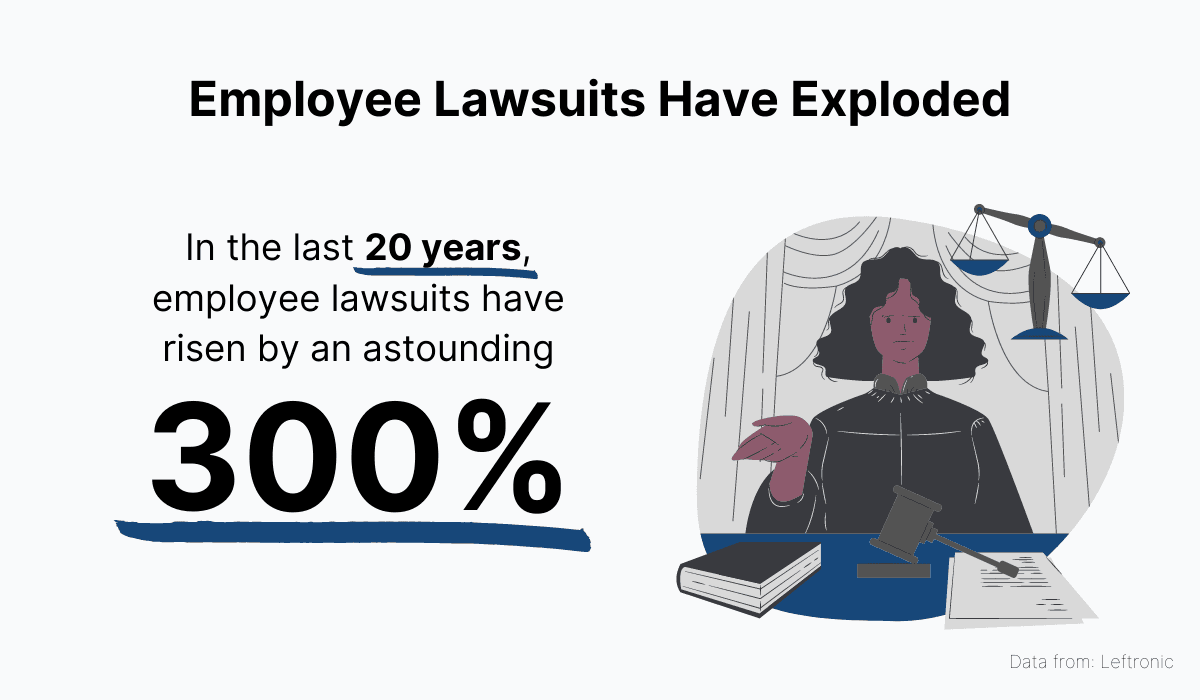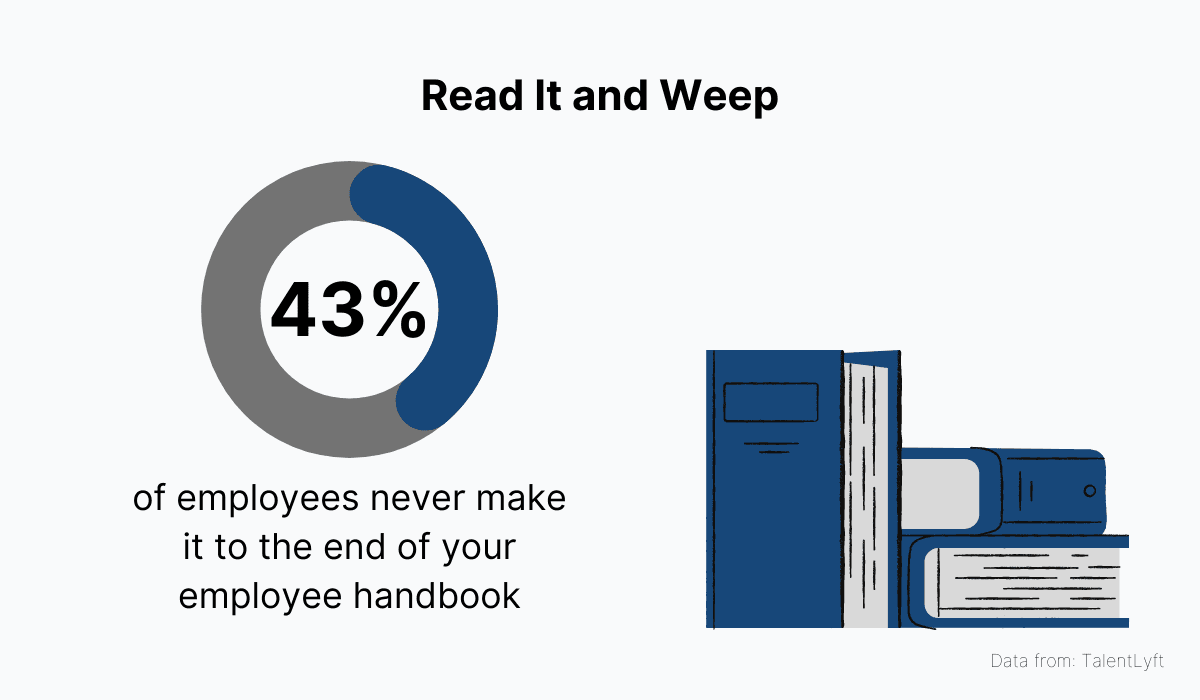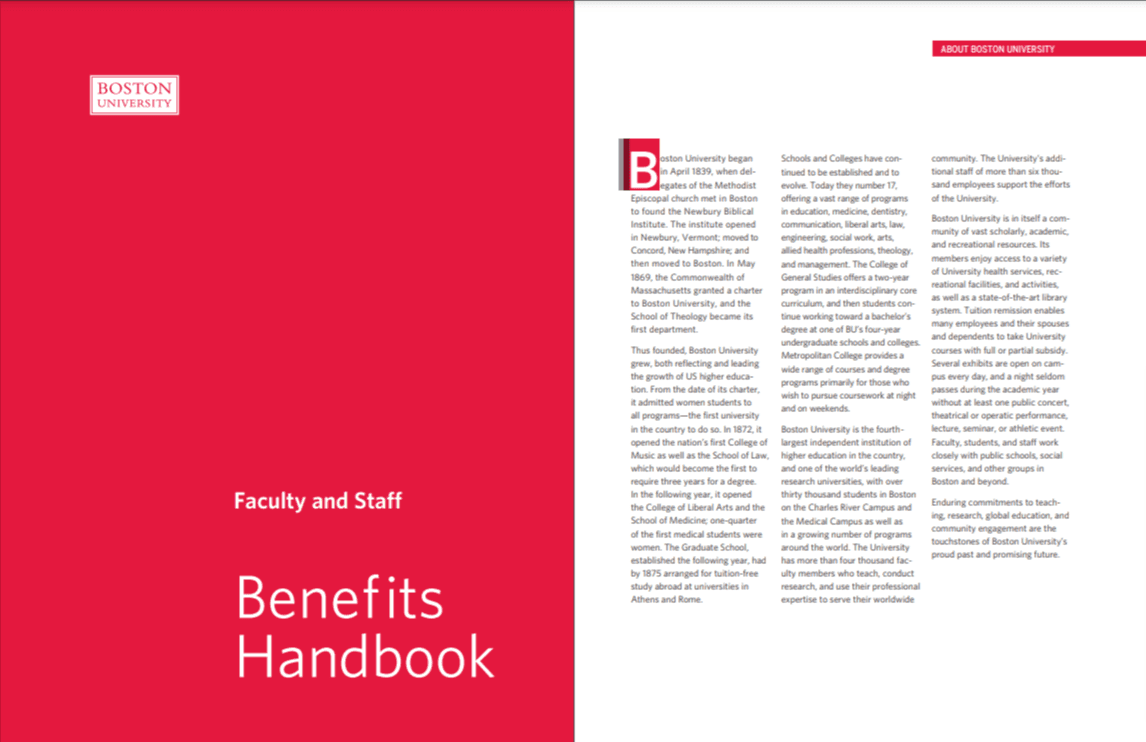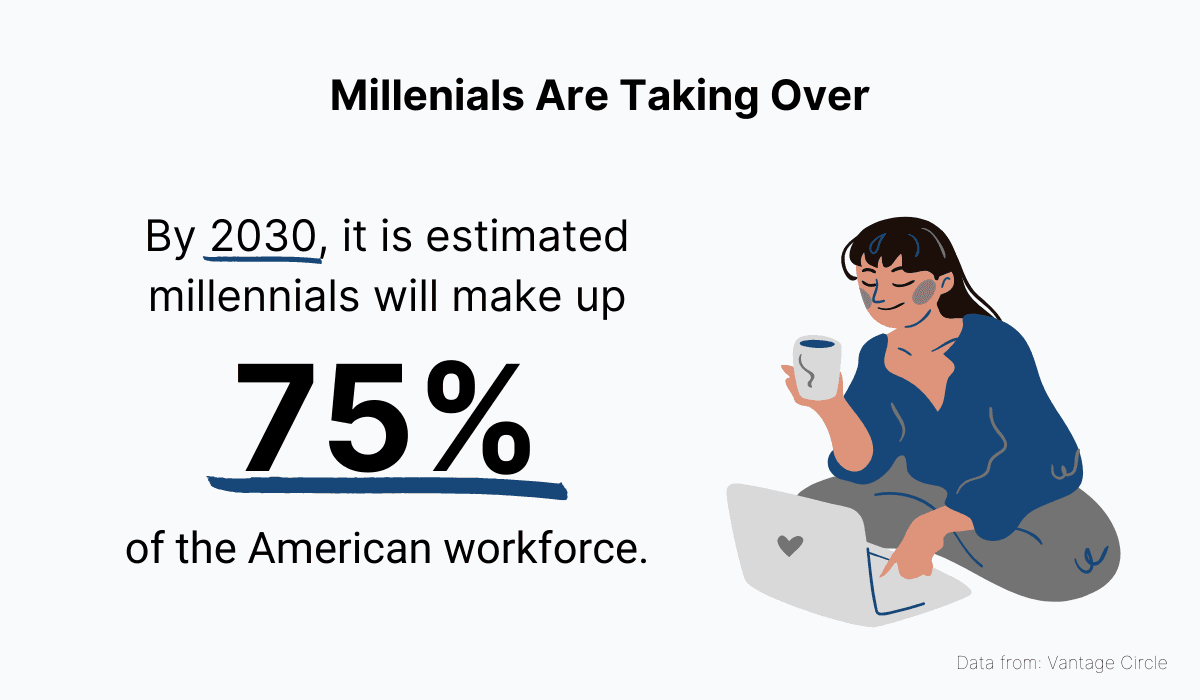With all the hustle and bustle of running a successful business, it’s easy to keep putting off creating an employee handbook for a less hectic time.
But it’s worth the effort to develop one. Not having an employee handbook in place can actually be quite harmful to your business.
Its purpose is not only to convey information and core values to the employees but also to protect your company from potential conflicts and lawsuits down the line.
Let’s take a closer look at the six main reasons why you need to have an employee handbook if you want to keep your business on track.
To Embody What Your Company Stands For
A good employee handbook usually starts with a clearly defined mission, vision, and some core values that the company represents—and with good reason.
If you think about it, your employee handbook is the first thing new hires will read when settling into their new role at your company. So this is a good opportunity to introduce them to who you are and what you do.

Source: Disqus
That way, new employees will get key information at the very beginning, helping them sync with your company's values, expectations, and culture later.
Your employee handbook can answer questions such as:
- How did it all start?
- What are the company’s future goals?
- What’s the philosophy behind the company?
- What are the expectations of new and existing employees?
The answers to these questions are the foundations of your company, and should therefore be displayed proudly in your employee handbook, as well as other places.
That way, they will continually remind the members of your organization of what you’re trying to accomplish together.
For example, Tesla has always been very vocal about their main mission: helping the world transition into sustainable energy. So much so that this mission statement is the first thing any visitor to the company sees upon entering the building.

Source: bigeek
We singled out this example because that focus on the company mission is reflected in their company handbook as well. The overall goal is super clear. Employees know what the company strives to achieve and what is expected of them in general.
Many companies have mission and vision statements that sound nice but are nothing more than a set of words without proper value behind them.
In Tesla's case, the core value is meaningful and hasn't changed in ten years, which shows authenticity and consistency.
Why are we mentioning all this?
Simply put, because a clarity of purpose is strongly correlated to employee engagement.

Source: Archbee.com
As the data collected in a recent Deloitte survey tells us, employees will be more engaged at work if they believe in the company's mission, vision, and core values.
That’s because people like working for companies that bring a sense of greater purpose to their job and are willing to go above and beyond if they feel they are participating in something meaningful.
But this only works if the purpose is communicated and embedded into the organization. Therefore, introducing employees to your mission and vision is a good first step when it comes to boosting their performance and engagement.
Which is why this part of the employee handbook deserves special attention.
To Define Key Company Policies
When someone mentions company policies, the first thought that comes to mind is a tedious document full of rules and regulations.
Company policies are often perceived as legal documents filled with bans and lists of things you are not allowed to do. Simply put: a necessary evil.
But this couldn’t be further from the truth.
Having clear company policies is extremely valuable for both employees and employers.
In fact, if you want your company to run like a finely-tuned machine, you need to set rules of engagement.
So why are company policies so important?
For one, they protect the rights of the employees as well as the business interest of the employer.
They’re the shield that guards both parties against disputes or misunderstandings that could potentially arise because they arm both parties with practices that help avoid gray areas and potential conflicts down the road.
While some parts of company policies are legal in nature, others are more provisory and offer guidelines regarding performance and behavior.

Source: Archbee.com
These regulations depend more on how employers wish to regulate their workplace and workforce.
They tend to outline the following:
- paid time off and holidays
- work hours and overtime
- dress code
- technology use
- benefits like health care, dental insurance, etc.
In addition to that, company policy is always a reflection of the organization’s culture and values. It’s another way of showing your employees what you stand for and signaling that your company is a human enterprise, not just a collection of rules and regulations.
For instance, inspired by the Black Lives Matter Movement, many companies added Juneteenth, the day that celebrates the end of slavery in America, to their holiday calendars.

Source: Findspark
Companies like Nike, Twitter, Square, and Starbucks wanted to be a part of this positive cultural change. So they offered their employees the opportunity to commemorate this day as a paid holiday.
As you can see, company policies reflect the changes in the business and society and respond to the issues as they appear.
Looking from this perspective, an employee handbook is no longer a dull corporate manual but rather a useful go-to guide aimed at helping, validating, and protecting employees and employers alike.
To Protect Your Business From Legal Issues
To reiterate a previous point, neglecting your employee handbook can come at a steep price when it comes to your business. That’s especially true when dealing with legal issues.
A well-written legal part of an employee handbook is your first line of defense against lawsuits concerning harassment, discrimination, wrongful termination, violations of privacy, intellectual property, etc.
And with employee lawsuits on the rise, it’s important to stay ahead of legal issues and be clear about what is and what isn’t acceptable in the workplace. Your employee handbook is perfectly suited for that task.

Source: Archbee.com
For example, many forward-thinking businesses have incorporated social media guidelines in their employee handbook to keep themselves out of hot water.
This kind of policy basically sets boundaries for the employees when it comes to their social media presence and helps prevent conflict between the employee and the company.
Adidas, the sportswear giant, took a clear and concise approach when creating its social media guidelines.

Source: Adidas
They encourage employees to talk about their work online but highlight that they expect them to follow several rules.
Some of these rules include:
- Taking responsibility for their own content
- Speaking for themselves, and not for the brand and company
- Respecting copyright and confidentiality regulations
With these guidelines, Adidas put some of the brand’s public image in the hands of the employees, making them accountable for the reputation of the brand and preventing missteps on social media that could have resulted in disciplinary action, termination, or even litigation.
Knowing where to turn for guidance in these matters is pivotal, which is why legal provisions and procedures are one of the first chapters of any employee handbook.
For easy reference and continuous access, many businesses place their handbooks online to make them easily accessible, leaving little room for uncertainty and misinformation. That way, everyone knows what the rules are and how to follow them.
A good way to make your handbook easily accessible is to use quality documentation software, like our own product, Archbee.

Source: Archbee.com
With documentation software, everyone in the company can quickly look up the information they need, such as a legal provision or code of conduct, and act according to the rules, with minimal risk of putting themselves, or the company, at legal risk.
What’s more, documentation software allows you to easily modify all documents in your knowledge base, which means your rules, regulations, and legal provisions are always relevant and up to date.

Source: Archbee.com
With Archbee, you no longer need to reprint your handbook or add additional sections. You can make changes online in real-time to make sure everything is up to date and in one place.
Remember, if you want to protect your business, as well as your workers, make sure your legal stance on all issues is always clear and easily found in your employee handbook.
To Provide Guidance to Your Employees
When starting a new job, questions like “Where will this job take me?”, “How will I fit in?”, or “Who do I report to?” are quite normal because, although exciting, starting a new job also has its uncertainties.
That’s why it is advisable to incorporate useful information in the handbook that will provide employees with guidance in terms of training, expectations, career progression, promotion, pay increase, and so on.
This will help employees get their bearings, tell them which career paths they can look forward to, and provide guidance on how to move up the company ladder.
Some of the more practical information your handbooks can contain includes, for example, who to contact if you are unable to come to work due to illness or other emergencies, how to handle company technology, what security precautions you can take, how to order office supplies, and so on.
And since this is usually a lot of factual information to absorb, it’s always a good idea to present the information in a creative, or one-of-a-kind way.
That should help you ensure the entire handbook gets read from cover to cover, which is something many new hires seem to struggle with.

Source: Archbee.com
This is important because uninformed employees are in danger of making preventable mistakes or feeling confused in their everyday work. And that can slow down progress and bring the onboarding process to a crawl.
Let’s look at a real-life example to explain this further.
One of the best and funniest employee handbooks we have ever seen is by PeopleHR, the HR management systems provider.
Their employee handbook is actually an onboarding manual for a new hire’s first several weeks at the company, and it contains loads of practical information for any situation.
But because of the excellent copywriting and art direction, this handbook is a real page-turner.

Source: PeopleHR
As you can see above, they use humor to keep readers engaged while sharing valuable onboarding information.
They manage to turn boring facts into entertaining pages that guide new employees through different stages of their training while promoting their ideal of a quirky and creative workplace.
PeopleHR has created a document that’s easy to grasp, fun to read, and an excellent introduction to the company and its values.
We bet that their new recruits have no trouble completing the handbook and absorbing all the information it contains with ease.
In light of all these benefits, it’s clear that good guidance in the form of an employee handbook can go a long way to increase your employees' satisfaction and engagement.
To Explain Company Benefits
One of the crucial things every employee wants to know more about are the company's perks.
Benefits like medical insurance, paid overtime, vacations, compensations, retirement benefits, and so on are the substantial weights that can tip the scale in favor of leaving or staying with the company.
But good perks can come in many forms. For instance, free coffee or a ping pong table, like the one at Weebly headquarters, shown below, can turn any workplace into a pleasant environment.

Source: Sharedspace
Whatever benefits you may be offering, an employee handbook is a good way to get them out in the open and provide clarity on how to use them. It’s also a good way to get new employees excited about working for the company from day one.
People like to be informed. Few things are worse than finding out that you were eligible for a particular benefit, but you never made use of it because you were uninformed.
That’s why it’s important not to leave your employees in the dark regarding something as important as the perks and benefits they’re eligible to receive.
Boston University does a good job with this. Their employees receive an entire handbook dedicated to benefits so that each employee knows what they’re entitled to and how to make use of it.

Source: Boston University
Their 152-page long manual covers benefits from health and dental insurance, disability and retirement plans, to tuition programs and educational expenses.
Most importantly, it is available to employees at all times as a reference handbook they can turn to every time they have concerns.
Therefore, with comprehensive manuals such as this, you need to spend much less time explaining the company's benefits and can rest easy knowing the information is there for anyone who wants to use it.
To Ensure a Consistent Employee Experience
Nowadays, it is common knowledge that employees are the most important asset of every business. That’s why companies go to great lengths to find the most skilled workers, hire the best talent, and attract top performers.
But all their talent and experience will be of no use if you fail to motivate them to use their potential.
So how can you succeed in such a challenging task, you may wonder?
One of the ways to do it is to provide a great and consistent employee experience.
According to studies, millennials will represent 75% of the workforce by 2030. And they are setting new rules for what a workplace should be.

Source: Archbee.com
They no longer want to work just for a paycheck or a list of benefits you put in front of them on a job interview. Work-life balance, equal opportunities, diversity, positive work culture, fairness, and meaningful work all make up the factors that motivate them to do a better job.
By taking time and effort to create a handbook with extensive information on worker rights and obligations, you are enabling all your employees to have access to the same information, which contributes to a more honest and fair work environment.
That’s because a set of rules that applies to all employees equally helps you prevent serious issues such as favoritism, double standards, and misalignment, which could affect the company culture and cause your workers to quit.
Take the Netflix employee guide as an example—it’s very successful in explaining the company’s culture. All seven aspects of it!

Source: Netflix
In 129 straightforward slides, Netflix’s employee guide explains how to advance at the company and which behaviors and traits are undesirable.
Netflix sets the record straight: they have high expectations of their employees. They value meaning, not form. It’s about effectiveness, not effort. They want to create a work culture built on freedom and responsibility. They strive for excellence and reward stellar employees accordingly.
And this goes for every employee at the company, regardless of department or tenure.
No wonder millennials want to work for Netflix. We all do after reading this handbook.
So to reduce the churn rate and make sure your top talent stays with you for years to come, start with describing inspiring employee experience and work culture in your handbook.
Then stick to it if you want to have happier and more motivated employees.
Conclusion
With the last reason on our list, we’ve come to the very end of this article.
Hopefully, we’ve managed to show you that an employee handbook can be much more than a corporate manual filled with long paragraphs that nobody reads, and brings real benefits.
It can be a valuable source of information for employees, set high standards, encourage fairness and equal treatment, and create a more positive work culture.
At the same time, it is legally beneficial to the employer as it can help protect the company in case of any legal disputes.
We spend a significant portion of our day at work, and a good employee handbook that sets the rules of the game can turn our time there into a more relaxing and inspiring experience.
All the more reason to go on and create one for your business, if you haven’t already.
FAQ
Frequently Asked Questions
An employee handbook is your company’s single source of truth. It aligns everyone around your mission and values, sets clear expectations for behavior and performance, explains policies and procedures, outlines rights and responsibilities, and shows employees how to access benefits and support. It also helps managers make consistent decisions and provides documentation that reduces confusion, speeds up onboarding, and lowers legal risk.



